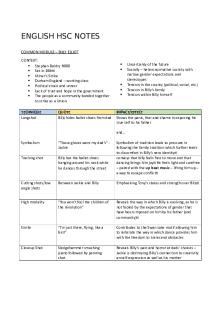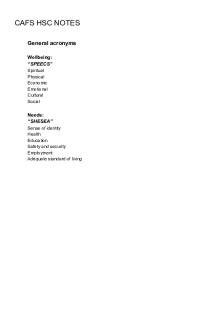HSC Visual Arts Unseen Notes PDF

| Title | HSC Visual Arts Unseen Notes |
|---|---|
| Author | Helena |
| Course | HSC Trial |
| Institution | Lindisfarne Anglican Grammar School |
| Pages | 4 |
| File Size | 180.8 KB |
| File Type | |
| Total Downloads | 40 |
| Total Views | 182 |
Summary
Excludes content areas, some general unseen info (96 in trials)...
Description
For answering unseens (excludes content areas)
Intentions
Choices
Historical • Wealth & patronage • A moment in time recording the appearance & status of royalty
Modern 1860s-1970s 1. Throw away every convention of art, breaking down traditional barriers between art forms & what is regarded as art. 2. Art has no utility or function other than itself 3. Metanarratives to create Utopian society: • Rationalism: simplification is improvement • Control: violent end to all tradition Progress: find utopia, • technology will improve everyone's lives
Emotive features/ intense, focused facial expression, dramatic features, mouth set, eyes focused, emphasis on balance & perfection of human body -> allusion to perfection of the mind, emphasizes human potential. - Smooth texture harmonises work & evokes a sense of unity OR Sculpting/painting/drawin g/architecture Sculpture: No individuality, static & mythical
Challenge conventions of the academy which were adherence to biblical, historical, mythological narratives & role of artist as a skilled creator. Reevaluate traditional artistic notion of "artist genius" and "masterpiece", proving that refined technique of a painter is unnecessary to produce the artwork. - Elevating an ordinary object to an art form is the artist's choice - Manufactured by other people, instead of by the artist's hand - Highlights the societal value placed on concept over manual skill
Hand made, labour intensive construction conveys that artists' skill & craftsmanship/handmade artworks are valued - Conventions of academic art - Marble: Carving with chisel, subtractive filing to smooth
Celebrating formalist qualities of abstraction, arts for arts sake, Avant Garde: artists at the forefront of innovation, need to dismantle
Postmodern 1970s onwards 1. Revisionist view: Challenge/extend accepted past conventions of art and mainstream views of society that have shaped the history of art 2. Question the role of the art in contemporary society, that it should be evocative and tell something about the audience, instead of merely an artistic indulgence 3. To suit diversity of cultural groups, pluralistic tastes
1)Employing new technologies to create hybrid art forms - Consisting of heterogeneous parts - Hybrid use of / pluralistic approach of traditional & non traditional techniques, media, form - Chaotic and fragmented, dynamic, characterised by variety and multiplicity. Incongruous elements - Not physical, but transient & ephemeral, compared to precious, permanent traditional works. use of paper as
ephemeral medium. photographic documentation becomes part of the artist’s practice due to temporal nature of the artworks 2)Collaborative postmodern practice, Fabricated, pre-made, put together: reject traditional notion of "artist genius". Influence of other art conventions, e.g. appropriation, inclusion of texts 3)Return of subject matter & categories rejected by modernism (revival of realism, landscape, narrative, history) & traditional techniques 4)Use of non-traditional art materials 5)Challenge traditional hierarchies between high & low art • Challenge artist as genius, artworks as masterpiece; made only by white
-
Influences/ world
Audience & artist
Technical skill shows agitated movement & excessive emotionalism
Religion, humanism, antiquity, historical conventions, narratives to inform audiences o Stylistic approaches informed by convention of the time o Techniques informed by conventions & available technologies
conventions to reflect new ideas & attitudes of the time, to define new roles for themselves
• • •
European men; fine art opposed to inferior popular culture 6) Challenge prevailing, traditional views of what is of value in art; question dominant values held by society, critique dominant power structures • Challenge cultural, racial and gender boundaries • Advocate for marginalised groups
Secularism, progress, modernity Rejection of historical conventions Technology: 1760 industrial revolution: new media e.g. photography, phone, x-ray, film
Audiences' experience is a passive one, admiring the artists' craft and trade
Changing role of audience as artworks shift from place & time to time-based work
Exhibitions: curatorial practice
Artists are not genius in creating masterpieces, they are a facilitator who creates experiences for the audience, while audiences play a central role in the space - Artist want audiences to control the artwork in order to facilitate the audiences' rich experience Audiences can engage with artwork in ways: - Physically, intellectually, emotionally, spiritually - Passive/active, intentional, interactive - Subjective audience responses
Audiences are usually patrons who commission the portraits Documenting history for audiences prior to photography Artists as sole practitioner
Sitter in portrait works, specifically: commission, competition and performance
Challenging role of art as fine arts and consumable product
• • • •
Commercialism, popular culture High & low art Blurring boundaries Hybrid expressive form crossing boundaries between painting, tapestry & sculpture comments on the multicultural nature of the postmodern world
Redefines the need for the audience to be physically present - accessible at any time, however their experience would have much less impact Provides most intimate & active connection with the artwork for some, but also a virtual experience, much less connected than traditional audience experiences Involves audiences, pose questions for them, rather than providing answers. Interpretations can change in different contexts Subverting traditional artistic forms, that works don't need to be in a gallery to have lasting value. Whereas, true experience of artistic value is found in interplay between audience and artist. More dynamic & different - Is relational in how it engages audiences
Traditional roles of galleries and museums have changed due to the changing nature of art practice. Changing traditional exhibition modes: site-specific works, performance art, installations and ephemeral works, which allow greater exposure to diverse audiences
Traditional art time period characteristics •
Ancient Greece & Rome: life-like representation of form & idea to idealise and celebrate beauty of human form o o
Recognizes physical beauty, truth, harmony - harmonious society Convention: drapery, gaze
Convention: male is active, female is passive Christian & Byzantine art: Adherence to biblical narrative through symbolism & religious subject matter. Stylised artworks o
•
o o
Symbolic, unreal flat background & buildings Jesus, Virgin Mary - icons as religious object
o
Tempera: egg & water, hatching, strokes, dried rabidly -> harsh lines
•
Renaissance: 1400s-1700s o Represent both religious & mythological subject matter to convey reverence for gods while celebrating the individual through the philosophy of humanism § patrons commission self-portraits § Individuals should play active role in taking control of their destiny o Influence of artworks from ancient Greece, adherence to historical conventions (e.g. looks to the ideal art of ancient Greece) & duty to revive literature suppressed from ancient Greece
o
Stretched canvas, oil & tempera -> luminosity & depth. Sfumato tonal blending to create feeling of softness & naturalism without use of harsh outlines Conventions • Nude female form. Voyeur. Depict as passive object • Convention from early Christian culture: appropriate mythological subject matter & contrapposto (asymmetrical human figure arrangement) of classical artworks • Chiaroscuro: high contrast between light & dark, shows artist's understanding of 3D form, light & space • Naturalistic pose: shows artist's understanding of anatomy • Linear perspective: visual code pointing to philosophy of humanism, place audiences in centre of ideal world, reinforce their central role • Geometry: scientific pursuit to inform composition of works by direct observation. E.g. circle symbolized perfection Unione: slow gradation of color with more vibrant & saturated colors, e.g. robe of woman Cangionte: changes in hues to depict shadows & highlights, e.g. dark green shadow, yellow highlight
o
Postmodern techniques / conventions: Appropriation/quotation: borrowing from history, making references to diverse range of artists, cultures & media from past Eclectic: mixture of elements selected from wide range of sources Pastiche: mixture of styles & materials Parody: artwork that imitates style of another artist in humorous/satirical way Recontextualizing: make references to image/idea from past or another culture, place in new context to • Allow artists to comment on the meaning of original image & viewer's association with it • Convey new meanings to contemporary audiences, that speak to them about issues of contemporary relevance/expose untruths and inconsistencies in historical and cultural narratives • E.g. recontextualize historical images & conventions Multiculturalism: The$acceptance$and$use$of$many$different$cultural$values.$ Plurality of styles • Interactive works, e.g. performance • Documented performances • Photographs, animations • Photoshop & digital editing • Street art • Appropriated Nihilistic view: life without meaning, purpose. Suspends all human general aspects of human life that are culturally accepted, e.g. technology did not improve lives Ephemeral art that occurs once, cannot be embodied in any lasting subject to be shown in museum or gallery Modernism timeline 1850~ 1900 Impressionism: capturing impression of an environment 1860~1900 Post-impressionism: intense, arbitrary color & stronger geometric forms 1905~1910 Fauvism: intense, bold dramatic lines & forms - emotional responses 1905~1925 Expressionism: distorted reality for emotional responses, bright, unusual color 1960: Abstract impressionism: large scale, spontaneous gesture, personal expression 1907 ~ 1915 Cubism: fragmented form w/multiple viewpoints, distorting shapes geometrically 1909~1914 Futurism: expression of movement, speed & power, inspired by industrial advancements 1915~1924 Dada: "anti art" to shock and ridicule, highly satirical, denial of aesthetic & tradition 1924~1965 Surrealism: exploration of dreams and subconscious 1953~1970 Pop art: use of images from popular culture, theme of consumerism & commercialism 1960~ Postmodern...
Similar Free PDFs

HSC Visual Arts Unseen Notes
- 4 Pages

Visual and Performing Arts
- 8 Pages

Visual Arts Assessment Task
- 3 Pages

Visual Arts lesson plan
- 3 Pages

Visual Arts Essay
- 5 Pages

English HSC Notes
- 9 Pages

SDD HSC Full Notes
- 74 Pages

Shelter HSC Notes
- 13 Pages

CAFS HSC Notes
- 33 Pages

Ancient History HSC Notes
- 9 Pages

SDD HSC Notes, full
- 2 Pages

Shelter notes HSC
- 8 Pages
Popular Institutions
- Tinajero National High School - Annex
- Politeknik Caltex Riau
- Yokohama City University
- SGT University
- University of Al-Qadisiyah
- Divine Word College of Vigan
- Techniek College Rotterdam
- Universidade de Santiago
- Universiti Teknologi MARA Cawangan Johor Kampus Pasir Gudang
- Poltekkes Kemenkes Yogyakarta
- Baguio City National High School
- Colegio san marcos
- preparatoria uno
- Centro de Bachillerato Tecnológico Industrial y de Servicios No. 107
- Dalian Maritime University
- Quang Trung Secondary School
- Colegio Tecnológico en Informática
- Corporación Regional de Educación Superior
- Grupo CEDVA
- Dar Al Uloom University
- Centro de Estudios Preuniversitarios de la Universidad Nacional de Ingeniería
- 上智大学
- Aakash International School, Nuna Majara
- San Felipe Neri Catholic School
- Kang Chiao International School - New Taipei City
- Misamis Occidental National High School
- Institución Educativa Escuela Normal Juan Ladrilleros
- Kolehiyo ng Pantukan
- Batanes State College
- Instituto Continental
- Sekolah Menengah Kejuruan Kesehatan Kaltara (Tarakan)
- Colegio de La Inmaculada Concepcion - Cebu



